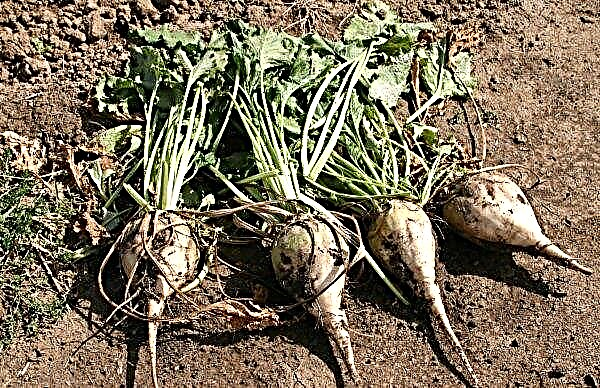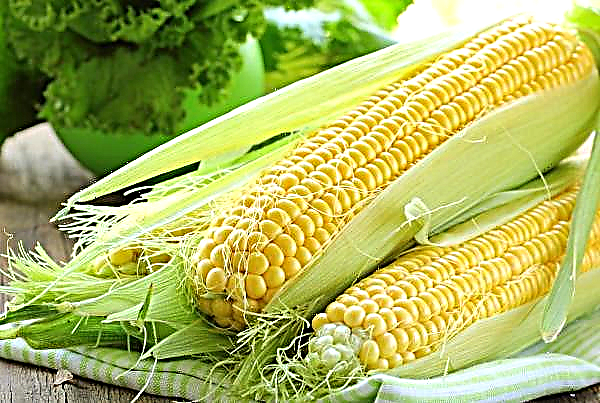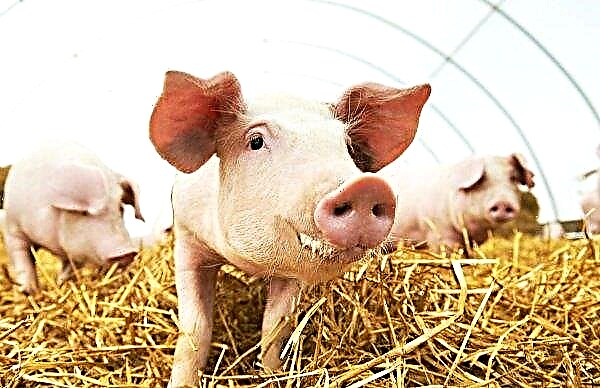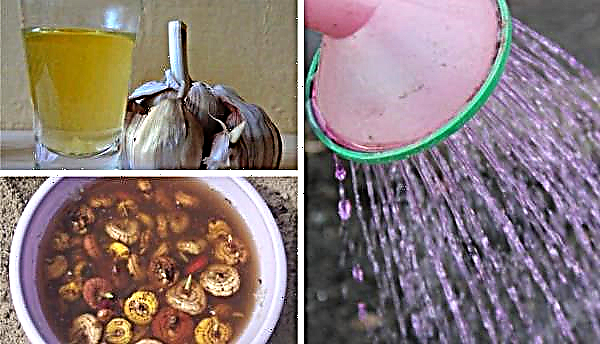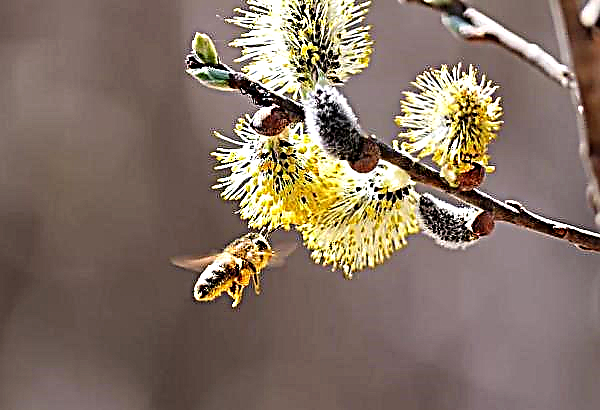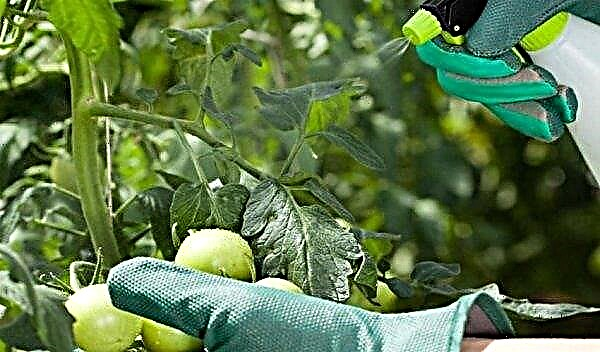The popularity of irises is due not only to their decorativeness and versatility in landscape design, but also to the simplicity of care and undemanding to growing conditions. Experienced flower growers even when planting bulbs apply agricultural techniques aimed at enhancing the splendor of flowering and its extension. They will be discussed further.
Where to plant irises
Like all members of the Iris family, these herbaceous perennials quickly take root in a temperate and subtropical climate. But they develop best in open and well-lit areas with loose, slightly loamy soil.

When choosing a seat, you should beware:
- lowlands where cold air masses gather;
- shady areas near adjacent tall buildings and plants;
- drafts;
- depleted as well as acidic soils;
- excessive dampness and waterlogging (these flowers do not like flower beds with high standing groundwater).
Did you know? Translated from the ancient Greek language, “iris” means a rainbow. It is believed that Hippocrates, who gave flowers this name back in the IV century BC. e., thus perpetuated the name of the mythical goddess Irida, who, carrying people the will of the Olympic gods, each time descended to the earth along a rainbow arc.
Experts advise choosing slightly elevated zones for irises, which are illuminated throughout the day. Light penumbra is also acceptable. Keep in mind that you can achieve maximum comfort for the Iris only in well-drained land.
How to dig earth
In order to plant a perennial, you must first prepare the site. This stage is:
- cleaning the area from fallen leaves, previous plants, debris and weeds;
- digging the ground deep with a bayonet-shovel.

All preparatory work is best planned in the fall, so that the land rests during the winter and most pests die in it. If the flower planting is planned in October, the preparation of the area should be done at least a few weeks before.
It is also not bad to fertilize the substrate with mineral complex substances. It is important that they be labeled "Autumn".
Important! When buying planting material for irises, instances with a strong and holistic root system, well-developed buds, and saturated green foliage are preferred.
Weed removal
The proximity of weeds badly affects the development of iris bushes, affecting the quality and quantity of their inflorescences. Therefore, the selected area should be carefully weeded during the preparatory work and immediately before rooting the seedlings.
Wild crops such as:
- wheat grass creeping;
- hogweed;
- mokret;
- edible dream;
- sow thistle;
- knotweed.

In severely neglected cases, chemical treatment of the terrain with herbicides is not excluded.. In the fight against the aforementioned weeds, the preparations Roundup and Hurricane Forte have proven themselves well. It is important that after spraying enough time has passed for the growth of new plants in the treated area.
If you are afraid of agrochemistry in your garden, you will have to eliminate unnecessary vegetation manually. In this case, be sure to shake out the rhizomes and take out the torn grass from the site. Otherwise, the flower garden will soon become clogged again and the desired crops will suffer from a lack of oxygen and nutrients in the soil.
Did you know? In Japan, straight and long leaves of iris are associated with samurai swords.
The best chemical composition of the earth
Irises of all types are unpretentious, but in an unfavorable soil environment they cannot fully develop and bloom. Therefore, it is desirable to plant them exclusively in a light loamy or sandy loamy substrate with a neutral or slightly acidic reaction.
High acidity of the soil will adversely affect the bushes. They will build up green mass, but will not be able to form buds. Therefore, if there are no suitable conditions on the flower bed, they will need to be adjusted artificially.

It is carried out according to the rules below:
- On poor sandy soils, before planting irises, it is extremely necessary to introduce clay and nitrogen-containing fertilizers.
- The oxidized environment can be neutralized with calcareous cannon, dolomite flour, cement dust or old plaster, wood ash, chalk, contributing 150-300 g per 1 m².
- Heavy soil compositions are adjusted using peat, river sand or compost five years ago.
- Peat substrates are improved with the help of organic fertilizers.
How to plant
Experts consider autumn to be the best period for rooting irises.
In order for the plant to quickly adapt to new conditions, it is necessary:
- Shorten the roots and foliage of seedlings by a third.
- If necessary, clean and disinfect the affected root processes. This procedure is relevant when transplanting diseased specimens. It is better to carry out a weak solution of potassium permanganate.
- Make holes of the appropriate depth (3-5 cm), observing the distance between adjacent bushes within 1 m. The plants grow rapidly and do not tolerate frequent replanting, therefore, in cramped conditions, they can completely stop blooming.
- Water the grooves made, place the roots of the plant in them and sprinkle them with earth. After that, seal the hole.
- Mulch the area with peat, compost or mowed grass. Mulch will prevent weed growth and retain moisture in the soil.

Watering and feeding
Breeding varieties of irises, as well as wild ones, may well grow without human intervention. But for productive cultivation, the grower needs to periodically take the following measures:
- Weather dependent water the crop, since it belongs to the hygrophilous floristic group. In a drought, this procedure is appropriate at least once a week. And in the rainy season you need to wait until the soil dries to a depth of 2-3 cm.
- Every six months update mulch on the site.
- Throughout the growing season fertilize the soil three times in the flowerbed. For the first time, this must be done with mineral complex substances when the bushes are covered with dense foliage. The second top dressing from organic substances (rotted hay or compost) is appropriate at the beginning of flowering, and the third, potassium phosphorus, is when the flowers begin to fall off.
- Regularly remove faded peduncles. This is done in order to accumulate the strength of the bush for new buds.
- Every fall, when the weather is stable and cold, cut foliageleaving up to 15 cm from the surface of the earth. Pruning too early will cause an intensive build-up of green biomass, which could lead to freezing in winter.
- Transplant irises every 5–10 years. This feature of culture is associated with a long period of its adaptation in a new place. Therefore, the annual transplant is not relevant.
- Mulch the soil annually in autumn in the flower bed with a layer of peat or sawdust up to 7 cm thick. An excessively thick mulch will cause the roots to overheat, and thin, on the contrary, will not protect them from frost.
Important! Plants can be sprayed only in the morning or evening, protecting the inflorescences from the solution.
With proper care, iris bushes will decorate with their flowering any plot in a private household. The complete absence of inflorescences or their scarce number are obvious signs of gross violations of agricultural regulations. Proper planting will help prevent them.

